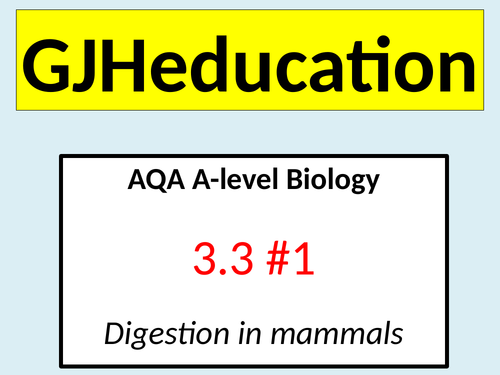







This lesson describes how large molecules are hydrolysed to smaller molecules by the enzymes produced by the digestive system in mammals. The detailed PowerPoint and accompanying worksheets are part of the 1st lesson in a series of 2 which have been designed to cover the content of point 3.3 of the AQA A-level Biology specification and this lesson includes descriptions of the action of amylase, disaccharidases, lipase, endopeptidases, exopeptidases and dipeptidases.
The lesson has been designed to walk the students through the functions of the digestive system at each point of the digestive tract up until the duodenum and focuses on the action of the enzymes produced in the mouth, stomach and small intestine and by the accessory organs of the system. Time is taken to describe and explain key details, such as the fact that endopeptidases cleave peptide bonds within the molecules, meaning that they cannot break down proteins into monomers. The lesson is filled with exam-style questions which will develop their understanding of the current topic as well as checking on their knowledge of related topics which have been previously-covered such as the structure of the biological molecules and qualitative tests. In addition to the detailed content and regular questioning, the lesson PowerPoint contains guided discussion periods and two quick quiz competitions which introduce a key term and a key value in a fun and memorable way
This lesson has been specifically planned to prepare the students for the very next lesson where the mechanisms for the absorption of the products of digestion are described.
Get this resource as part of a bundle and save up to 35%
A bundle is a package of resources grouped together to teach a particular topic, or a series of lessons, in one place.
Topics 3.1, 3.2 & 3.3 (AQA A-level Biology)
This bundle contains 7 lessons which are highly detailed and cover the following points in the surface area to volume ratio, gas exchange and digestion and absorption topics of the AQA A-level Biology specification: * The relationship between the size of an organism or structure and its surface area to volume ratio * The development of systems in larger organisms as adaptations that facilitate exchange as this ratio reduces * Adaptations of gas exchange surfaces in single-celled organisms, insects, bony fish and in the leaf of a dicotyledonous plant * The gross structure of the human gas exchange system * The essential features of the alveolar epithelium over which gas exchange takes place * Ventilation and the exchange of gases in the lungs * Digestion in mammals of carbohydrates, proteins and lipids * Mechanisms for the absorption of the products of digestion by cells lining the ileum If you would like to sample the quality of lessons in this bundle, then download the alveolar epithelium and absorption in the ileum lessons as these have been uploaded for free
Topic 3: Organisms exchange substances with their environment (AQA A-level Biology)
This lesson bundle contains 17 detailed and fully-resourced lessons which cover the following specification points in topic 3 of the AQA A-level Biology specification: Topic 3.1 * The relationship between the size of an organism or structure and its surface area to volume ratio * The development of systems in larger organisms as adaptations that facilitate exchange as this ratio reduces Topic 3.2 * Adaptations of gas exchange surfaces as shown by gas exchange in single-celled organisms, insects, bony fish and the leaves of dicotyledonous plants * The gross structure of the human gas exchange system * The essential features of the alveolar epithelium as a surface over which gas exchange takes place * The mechanism of breathing to include the role of the diaphragm and the intercostal muscles Topic 3.3 * During digestion, large molecules are hydrolysed to smaller molecules * Digestion in mammals by amylases, disaccharidases, lipase, endopeptidases, exopeptidases and dipeptidases * Mechanisms for the absorption of the products of digestion by cells lining the ileum of mammals Topic 3.4.1 * The structure and role of haemoglobin in the loading, transport and unloading of oxygen * The effects of carbon dioxide concentration on the dissociation of oxyhaemoglobin * The general pattern of blood circulation in a mammal * The gross structure of the human heart * Pressure and volume changes and valve movements during the cardiac cycle * The structure of the arteries, arterioles and veins * The formation of tissue fluid and its return to the circulatory system Topic 3.4.2 * Xylem as the tissue that transports water * The cohesion-tension theory of water transport * Phloem as the tissue that transports organic substances in plants * The mass flow hypothesis for the mechanism of translocation in plants If you would like to sample the quality of the lessons included in this bundle, then download the following lessons which have been uploaded for free Alveolar epithelium Absorption in the ileum Arteries, arterioles and veins Formation of tissue fluid Translocation
Something went wrong, please try again later.
This resource hasn't been reviewed yet
To ensure quality for our reviews, only customers who have purchased this resource can review it
Report this resourceto let us know if it violates our terms and conditions.
Our customer service team will review your report and will be in touch.